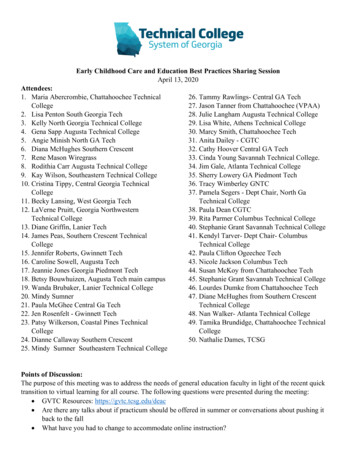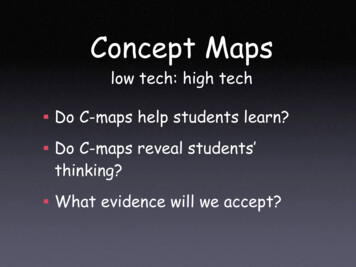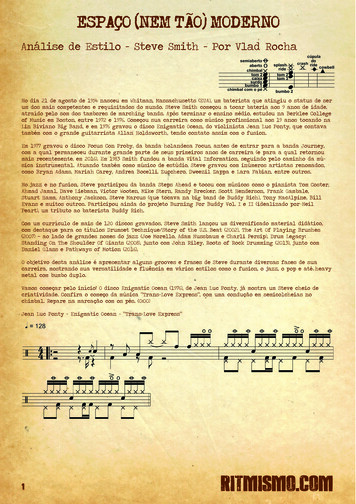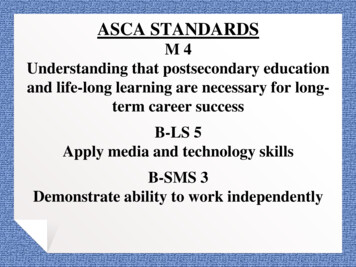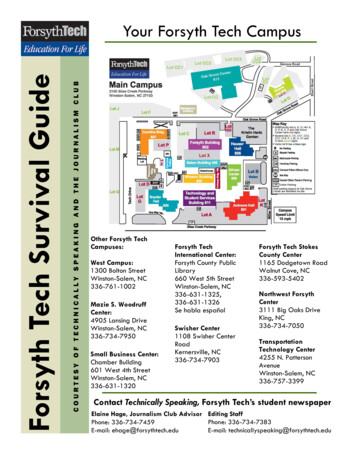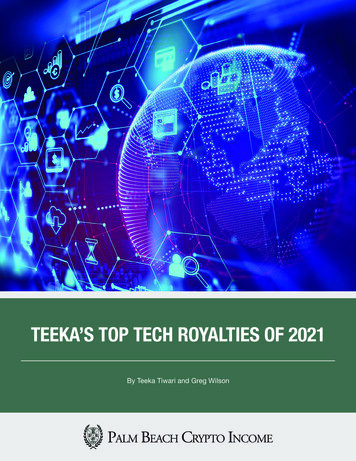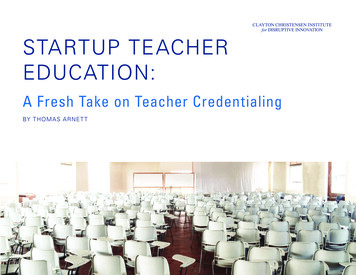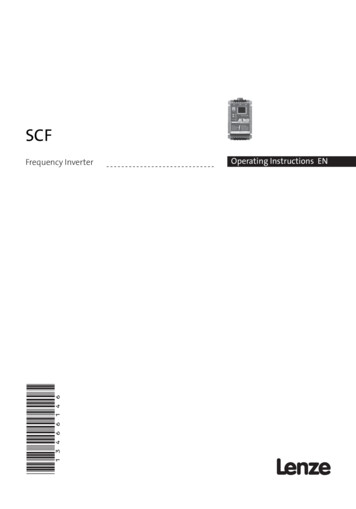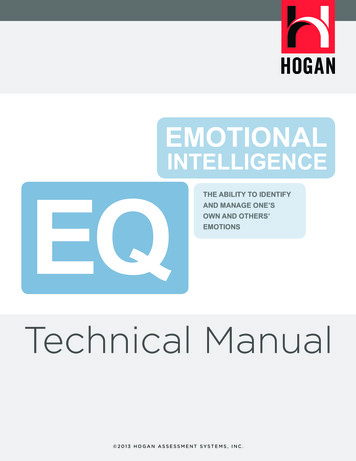
Transcription
EQTechnical ManualEMOTIONALINTELLIGENCEEQTHE ABILITY TO IDENTIFYAND MANAGE ONE’SOWN AND OTHERS’EMOTIONSTechnical Manual 2013 HOGAN ASSESSMENT SYSTEMS, INC.1
EQTechnical Manual 2013 Hogan Assessment Systems, Inc.No part of this work may be copied or transferred to any other form or expressionwithout expressed written consent from Hogan Assessment Systems, Inc.Hogan Personality Inventory Hogan Development Survey Motives, Values, Preferences Inventory are the exclusive registered trademarks ofHogan Assessment Systems, Inc.hoganassessments.comISBN 978-0-9889286-4-0 (e-book)
EQTechnical ManualTable of Contents1 – Introduction71.1 Background .71.2 Overview.82 – Hogan Emotional Intelligence Model92.1 The State of EQ Research .92.2 Theory and Structure.92.3 Components.123 – Description of the Hogan Personality Inventory (HPI)143.1 Approach and Rationale .143.2 The Five Factor Model (FFM) .143.3 Comparing the HPI to Other FFM Instruments .153.4 HPI Description and Development .183.5 Homogeneous Item Composites (HICs).194 – Study 1: Development of HPI-Based EQ Scales224.1 Algorithms .224.2 Initial Scale Development .224.3 Analytical Procedures .244.4 Results .255 – Study 2: Validation of HPI-Based EQ Scales275.1 Method .275.2 Results .275.3 EQ Scale Correlations .285.4 Averaged EQ Scale Results.293
EQTechnical Manual6 – Description of the Hogan Development Survey (HDS)306.1 The Hogan Development Survey .306.2 HDS Description and Development .317 – Study 3: Development and Validation of HPI- & HDS-Based EQ Scales347.1 Scale Development .347.2 Results .348 – Applications and Recommendations368.1 Scoring .368.2 Simulated Adverse Impact .368.3 Uses and Applications.398.4 Accuracy and Completeness .399 – Compilation of Norms409.1 Importance of Norms for Interpretation and Decision-making .409.1.1 Presentation of Normative Data .409.1.2 Professional Standards for Norm Development .409.2 Norm Composition .419.3 Descriptive Statistics of the Norming Sample .42References44APPENDIX A: Sample Hogan EQ Report57APPENDIX B: Norms for the Total Sample664
EQTechnical ManualTables and FiguresFigure 2.1 Hogan EQ Model Conceptual Framework .10Table 2.1 EQ Components and Descriptions .13Table 3.1 Correlations between Goldberg’s Big-Five Markers and the HPI Scales .16Table 3.2 Correlations between the PCI Primary Scales and the HPI Scales .16Table 3.3 Correlations between the IP/5F and the HPI Scales .16Table 3.4 Correlations between the NEO-PI-R and the HPI Scales .16Figure 3.1 Relationships between FFM Inventories and the HPI Scales .17Table 3.5 HPI Scales, HICs, Descriptions, and Sample Items.20Table 4.1 Example Performance Criteria for EQ components.22Table 4.2 Theoretically and Empirically aligned HPI HICs.23Table 4.3 Validity Results for EQ Scales.26Table 5.1 Validity Results for Predicting Leadership, Employability, and Teamwork Ratings28Table 5.2 Correlation Results for the Hogan EQ Model .29Table 5.3 Validity Results for the Overall EQ Model .29Table 7.1 Theoretically and Empirically aligned HDS Scales .34Table 7.2 Validity Results for HPI & HDS-Based EQ Scales .34Table 8.1 Scale Means and Standard Deviations .36Table 8.2 Awareness Adverse Impact Results .375
EQTechnical ManualTable 8.3 Detection Adverse Impact Results .37Table 8.4 Regulation Adverse Impact Results .37Table 8.5 Influence Adverse Impact Results.38Table 8.6 Expressivity Adverse Impact Results.38Table 8.7 Empathy Adverse Impact Results .38Table 9.1 Hogan EQ Normative Sample (N 66,950).42Table 9.2 Norming Sample Scale Means and Standard Deviations .436
EQ1Technical ManualIntroduction1.1 Background Through most of human history, people have believed that emotions aredisruptive and affect our thoughts and behavior in negative ways. Emotions are believed toundermine our capacity for rational thought; this leads to the view that effective functioningrequires controlling emotions. For example, the Roman Stoic Publilius Syrus, writing in thefirst century B.C., stated: “rule your feelings, lest your feelings rule you.” Beginning with thegreat Scottish philosopher David Hume (1737/1969), more recent writers, including FriedrichNietzsche and Sigmund Freud, have argued that reason and emotion are inseparable, thatreason is necessarily “the slave of passion.”Modern psychological research has validated Hume, Nietzsche, and Freud: emotions areinseparable from reasoning (Bechara, Damasio, & Damasio, 2000) and integral to humanfunctioning (Izard, 1977). Far from being “acute disturbances” to reason, emotional responsesfollow logical patterns that actually help people respond to their environment (Izard, 1977),interact with others (Keltner & Haidt, 1999), and understand and respond to organizationalchange (Huy, 1999). Thus, emotions can be seen as crucial guides to social interaction (Seo,Barrett, & Bartunek, 2004). In Ekman’s (2003) words, emotions make life livable.In the business world, emotions influence peoples’ performance in their jobs and organizations(George & Brief, 1996). Emotions impact thinking, decision-making, teamwork, leadership, andother work-related behaviors (Barsade & Gibson, 2007; Brief & Weiss, 2002; Elfenbein, 2007;Weiss & Cropanzano, 1996). These considerations created considerable interest in the conceptof emotional intelligence/quotient (EQ; Cherniss, 2010; Goleman, 1995; Mayer & Salovey, 1997)because the EQ concept captures the intuitive insight that how people manage their emotionscan enhance or impede career success. Early research suggested that companies using EQassessments for selection realized significant improvements in sales, tenure, productivity, andnet profits (Cherniss, 1999). More recent research demonstrates that higher levels of EQ inleaders, sales people, customer service reps—any role that involves interacting with others—predicts greater individual effectiveness (Joseph & Newman, 2010).To help organizations identify job applicants with skill at managing emotions, HoganAssessment Systems (Hogan) developed an assessment designed to predict emotionallycompetent behavior. This report describes: (1) the Hogan EQ Model; and (2) the developmentof psychometric scales that align with the six components of the model. We provideevidence regarding the validity of the scales for predicting emotional competence and otherimportant work behaviors. The research conforms to standards outlined in the UniformGuidelines on Employee Selection Procedures (Equal Employment Opportunity Commission[EEOC], 1978; hereafter “Uniform Guidelines”), the Principles for the Validation and Use ofPersonnel Selection Procedures (Society for Industrial and Organizational Psychology [SIOP],2003; hereafter “Principles”), and the Standards for Educational and Psychological Testing(American Educational Research Association [AERA], American Psychological Association[APA], & National Council on Measurement in Education [NCME], 1999; hereafter “Standards”).In areas where the Uniform Guidelines, Principles or Standards proved vague or inapplicable,we relied on the broader scientific-professional literature for guidance.7
EQTechnical Manual1.2 Overview The research described in this manual relies on archival data using the HoganPersonality Inventory (HPI; R. Hogan & J. Hogan, 1995, 2007) and Hogan Development Survey(HDS; R. Hogan & J. Hogan, 1997, 2009) to predict EQ-related competencies. We used threestudies to create scales to assess EQ. In Study 1, we identified the facets of personality mostclosely related to the six components in the Hogan EQ Model (Chapter 2). First, we identifiedarchival studies containing criterion data that matched the competency definitions. Next, weexamined correlations between HPI HICs (Chapter 3) and these criterion variables. Finally,we evaluated the validity of the scales created using the HICs that best predicted eachcompetency (Chapter 4). In Study 2, we examined relationships between these scales andratings of various performance dimensions to provide additional evidence to support theutility of the scales for predicting diverse work outcomes (Chapter 5). Finally, in Study 3, weexplored the utility of including dark-side personality measures in each scale (Chapters 6 and7).This document, which describes this research, is organized in the following sections:Introduction – Overview of researchHogan EQ Model – Description of modelThe Hogan Personality Inventory (HPI) – Description of assessmentDevelopment of HPI-Based EQ Scales – Study 1 summaryValidation of HPI-Based EQ Scales – Prediction of Leadership, Employability, and Teamwork Study 2 summaryThe Hogan Development Survey (HDS) – Description of assessmentDevelopment and Validation of HPI- & HDS-Based EQ Scales – Study 3 summaryApplications and Recommendations – Application of algorithmsCompilation of Norms – Development of the normative dataset8
EQ2Technical ManualHogan Emotional Intelligence Model2.1 The State of EQ Research EQ concerns the competencies needed to recognize, process,and manage emotions (Zeidner, Roberts, & Matthews, 2008). EQ is not a new idea; itrepresents the latest incarnation of the broader search for capacities beyond cognitive abilitythat are important for social effectiveness (e.g., Chamorro-Premuzic, 2011; Gardner, 1983;Landy, 2005; Stricker & Rock, 1990; Thorndike, 1920; Wagner, 1987; Weis & Süss, 2005).To better understand EQ, consider an internal marketing consultant who has developed abrilliant campaign that will increase her company’s market share by 125%. She knows thather boss is risk averse and more anxious at the beginning of each week due to built-up clientdemands from the weekend. High EQ helps her recognize and understand her manager’semotional state, prompting her to wait until the end of the week to propose her idea.Goleman (1995) popularized EQ for human resource applications, and the idea was adopteduncritically (cf. R. Hogan & Stokes, 2006). Goleman proposed EQ as a cure to dysfunctionalleadership, general angst, and unethical conduct, noting that EQ is “as powerful and at timesmore powerful than IQ” in predicting success and curing strife in life (Goleman, 1995, p. 34).Goleman (1995) further described EQ as an assortment of preexisting positive characteristicssuch as political awareness, achievement orientation, and conscientiousness (pp. 26-28).Goleman’s views on EQ often went beyond available evidence (Davies, Stankov, & Roberts,1998; Epstein, 1998; Matthews, Roberts, & Zeidner, 2004; Mayer & Cobb, 2000) and led to aproliferation of multiple EQ instruments, research streams, and academic backlash (Landy,2005; Locke, 2005; Murphy & Sideman, 2006).The most frequent criticism of EQ concerns the breadth, redundancy, and multiplicity of itscontent across models (Mayer, Salovey, & Caruso, 2008), which led Locke (2005) to ask,“what does EQ not include?” (p. 428). In contrast, proponents argue that EQ is a coherentdomain covering a wide array of emotional, social, and personal competencies (e.g., Bar-On,2004; Chamorro-Premuzic, & Furnham, 2010; Cherniss, 2010; Petrides & Furnham, 2003). Acursory examination of the literature, however, suggests there is no clear consensus regardingthe substance of EQ. Representations of EQ range from mental ability-based models (e.g.,Mayer & Salovey, 1997) to contextually-bound knowledge of rules for appropriate feelings(Denham, 1998; Izard, 2001), to a complex interplay of emotional, mood, personality, andsocial orientation (Bar-On, 2004).Additional critiques of EQ concern the psychometric issues that plague self-report “mixed”models (Roberts, MacCann, Matthews, & Zeidner, 2010). Further, alternative competingmeasures and conceptions of EQ tend to be uncorrelated, suggesting that they measuredifferent constructs (Van Rooy & Viswesvaran, 2004; Zeidner et al., 2008).2.2 Theory and Structure An alternative approach to assessing EQ is to organize the variousEQ models into a single, more comprehensive, model (Cherniss, 2010; Giardini & Frese, 2007;Zeidner et al., 2008). Following other recent EQ competency integrations (Bartram, 2005;Joseph & Newman, 2010; Lievens & Chan, 2010; Scherer, 2007), we conceptualize EQ as aset of distinct but related constructs. Furthermore, each construct is a partial mediator of9
EQTechnical Manualthe predictive effects of personality on career, relationships, and work success. Our modelattempts to reconcile opposing arguments regarding the assessment of EQ (Lievens & Chan,2010).EQ critics argue that various conceptualizations of emotional competencies (e.g., mixedmodel EQ) are based on the same underlying personality dimensions (e.g., Locke, 2005;Murphy & Sideman, 2006) and are therefore not unique. However, this criticism overlooks theincremental validity that EQ measures demonstrate over established personality measures(Chamorro-Premuzic, & Furnham, 2010; Cherniss, 2010; Joseph & Newman, 2010; O’Boyle,Humphrey, Pollack, Hawver, & Story, 2010; Zeidner et al., 2008). On the other hand, EQadvocates (e.g., Cherniss, 2010; Goleman, 1995; Petrides & Furnham, 2003) focus on themultidimensional competencies and correctly argue “their” versions of EQ are proximal, andsometimes better (Joseph & Newman, 2010) predictors of performance. This view ignores therole of established dimensions of personality in determining their competencies and makesit difficult to determine how much EQ uniquely matters to work results relative to otherattitudes and personality characteristics. We avoid both issues by offering an intermediatemodel (elaborated below) in which emotional competencies occupy a “middle ground,”serving as mediating mechanisms between established personality attributes and workoutcomes (see Figure 2.1).Figure 2.1 Hogan EQ Model Conceptual FrameworkHogan EQ ModelIntrapersonalGeneral Attributes Mental ability Personality Experiences Interests, goals,and utcomesDetectionInfluenceEmpathy Career Success Performance OCBs Leadership Deviance Well-being LMX QualityThe model offered in Figure 2.1 incorporates commonly studied EQ components using thefour-branch model of EQ (Salovey & Mayer, 1997), its progenies (Law, Wong, & Song, 2004;Palmer & Stough, 2001; Tett, Fox, & Wang, 2005), and other affective and social competenceframeworks from the psychological literature (Halberstadt, Denham, & Dunsmore, 2001;McFall, 1982; Riggio, Riggio, Salinas, & Cole, 2003; Scherer, 2007). This model helps reconcilecompeting conceptual (Cherniss, 2010; Zeidner et al., 2008), psychometric (Joseph &Newman, 2010; O’Boyle et al., 2010), and developmental perspectives (Halberstadt et al., 2001;Scherer, 2007). Conceptually, it ties together diverse, oftentimes competing, views on EQ intoa single domain based on ability and emotional competence literatures. Psychometrically,10
EQTechnical Manualit helps articulate why personality and cognitive ability correlate with self-perceptions ofemotional capabilities and objective scores on ability-based EQ tests. Developmentally, itmaintains that individual differences facilitate the acquisition and expression of EQ over time.Theoretical Content. At the broadest level, most EQ models contain three components:perceiving, controlling, and sharing emotional signals (Chamorro-Premuzic, 2011; ChamorroPremuzic & Furnham, 2010; Halberstadt et al., 2001; Mayer & Salovey, 1997; Palmer, Gignac,Ekermans, & Stough, 2008; Riggio & Lee, 2007; Saarni, 1999; Scherer, 2007; Tett et al.,2005)1, and each component aligns with Gross and Thompson’s (2007) model of emotionalexperience: attention, assessment, and response. This three-part distinction is based onearlier models of clinical and communication training aimed at improving the “people skills”of managers: (a) the “decoding” of messages and social situations, (b) the processing ofsuch information, and (c) the “enactment” of an intended response (Riggio & Lee, 2007).Most EQ models also distinguish between self- and other-focused emotional competencies(Gardner, 1983; Tett et al., 2005; Weisinger, 1998). Research on emotions (Keltner & Haidt,1999), human performance (R. Hogan & Warrenfeltz, 2003), and intelligence (Gardner, 1983)suggests emotional functioning exists on different levels: inward vs. outward, private vs. social,and intrapersonal vs. interpersonal. Such perspectives place differential emphasis upon theexperiential vs. the social nature of emotions.Psychometrics. The relationships between the components of EQ, personality, and cognitiveability have been studied in detail. O’Boyle et al. (2010) estimate corrected correlations rangingfrom small to moderate (.11 to .54) between the Big Five personality factors and all major EQmodels. Thus, every existing EQ instrument is to some degree correlated with personality.Joseph and Newman (2010) provide meta-analytic evidence that conscientiousness is linkedto higher emotional perception and emotional stability with higher emotional regulation.They argue that conscientious individuals tend to be more self-conscious, and thus pay moreattention to other’s judgments, while neurotic individuals tend not to regulate their emotionseffectively. Other research suggests that: (a) approximately 2/3 of the variability in EQ canbe accounted for by personality variables, and (b) when neuroticism is scored as emotionalstability or adjustment, all Big Five factors are positively correlated with EQ (Webb et al., 2013).Development. Personality influences the types of situations and experiences we encounter(Buss, 1987; Snyder & Ickes, 1985) and the social roles we adopt (Roberts, 2006; Roberts& Wood, 2006), which then shape the types of competencies we acquire. For instance,agreeable people are much more likely to adopt “getting along” roles, such as volunteering(Carlo, Okunb, Knight, & Guzman, 2005; Graziano & Eisenberg, 1997). By doing so, they willcome to see themselves as altruistic and adopt additional helpful roles (Roberts & Woods,2006), which should further enhance and reinforce their capacity to empathize with andrelate to others (agreeableness and empathy are correlated, see Davies, Stankov, & Roberts,1Understanding and emotional facilitation are other common EQ components (e.g., Mayer & Salovey, 1997; Law et al.,2004). Understanding includes the ability to discriminate among emotions and imagine their effects (Mayer & Salovey, 1997) and tends to be correlated with crystallized forms of knowledge (e.g., verbal facts; Roberts et al., 2006).Because this is an index of emotional knowledge in the abstract rather than the live competence of EQ in the socialworld (see Scherer, 2007; Spector & Johnson, 2006), it is excluded. Second, emotional facilitation is the ability togenerate and use emotions to guide thought (Mayer & Salovey, 1997). However, multiple studies suggest this scale haspoor structural and construct validity (Gignac, 2005; Maul, 2011; Rossen, Kranzler, & Algina, 2008); some studies alsosuggest it is redundant with emotional regulation (Joseph & Newman, 2010). Thus, we exclude these two componentsfrom the current model.11
EQTechnical Manual1998; McCrae, 2000). Further, the ordering (i.e., arrows) of the EQ components in our modelare consistent with both cascading (Joseph & Newman, 2010) and pinwheel (Halberstadtet al., 2001) notions of development in which perceiving emotions is considered primaryto controlling and sharing emotions. One must first be able to detect an emotion (e.g.,perception) before being able to transform or manipulate the emotional content itself (e.g.,control). Finally, the interpersonal consequences of emotions are conveyed through thecapacity to interact with others appropriately (e.g., sharing).2.3 ComponentsEmotional Perception. Most models assume that the basic EQ competency is the ability toperceive and interpret emotional states (Ciarrochi, Caputi, & Mayer, 2003). Most theories alsoassume that being able to perceive one’s emotions and the emotions of others are separatebut related competencies.Therefore, the intrapersonal component of emotional perception, emotional self-awareness,is defined as being able to access, differentiate, and draw upon inner emotions to understandone’s relation to the current social environment. This awareness, according to Buck (1984,p. 4), allows us to regulate our behavior because we can identify the source of our currentemotional state. Recent research supports this notion, and suggests that persons withemotional self-awareness are less likely to let their moods interfere with their thoughts(Ciarrochi et al., 2003).The interpersonal component of emotional perception, emotional detection, is defined asthe ability to decipher the emotional signals of others. In most jobs, employees interact witha variety of coworkers who display emotions that provide information about their goalsand attitudes (Rafaeli & Sutton, 1987). A person who excels at emotional detection candiscriminate among genuine versus fake smiles and various gradations of other affectivestates (e.g., anger vs. irritation). Detecting colleagues’ emotions may facilitate coordinationand interpersonal functioning that may, in turn, enhance job performance (Law et al., 2004).Emotional Control. Emotional control refers to strategies for altering the emotional states ofoneself and others. Managing emotions is the “strategic” aspect of EQ in that it allows peopleto better attain their goals through direct manipulation of emotions with situational relevance(Mayer & Salovey, 1997).The intrapersonal component, emotional regulation, represents proficiency in amplifying,nullifying, or reversing one’s own emotional states. Joseph and Newman (2010) argue thatemotional regulation includes the ability to select effective coping strategies. Thus, individualshigh in emotional regulation will match their regulation strategies to the demands of tasks,thereby retaining more cognitive resources to maximize overall job performance (Joseph &Newman, 2010).Emotional influence refers to influencing the internal affective states of others. The capabilityto regulate a customer or client’s emotions, for instance, may lead to better interactionoutcomes (Lopes et al., 2004). Unlike regulation, individuals often use emotional influence topursue social goals, such as getting along with teammates.12
EQTechnical ManualEmotional Sharing. We base the emotional sharing component of our model on functionalaccounts of emotions (Frijda & Mesquita, 1994; Keltner & Haidt, 1999). Emotional sharingconcerns being attuned to situational demands in the form of contextually appropriateresponses (e.g., empathy to a customer’s personal plight with appropriate vocal and facialdisplays).Emotional expressivity, the intrapersonal component of emotional sharing, concerns beingable to convey desirable emotional states to external observers. Hochschild (1983) coined theterm emotional labor to refer to “the management of feeling to create a publicly observablefacial and bodily display” (p. 7). For example, customer service representatives need toconvey happiness, whereas bill collectors may portray anger to elicit payment (Elfenbein,2007). Research on emotional labor demonstrates that most jobs demand2 expressions of joy,happiness, and energy (Hochschild, 1983).The interpersonal component of emotional sharing, empathy, is defined as the capacity toexperience, share, and respond to the emotional state of another. The linguistic origins of theword empathy literally mean, “to feel into,” an important component of social experience.Empathizing with others facilitates norm compliance, communicative ability, and socialadroitness (Greif & R. Hogan, 1973). Being able to empathize with others creates deeperconnections at work, thus allowing people to engage one another in social interactions andcollaborative experiences (Kahn, 1992).Component Descriptions. Table 2.1 presents descriptions of high and low scores on eachcomponent of the Hogan EQ Model.Table 2.1 EQ Components and DescriptionsComponent2DescriptionAwarenessLow scorers are detached from themselves and their surroundings. High scorers areresponsive and present.DetectionLow scorers misinterpret others’ intentions, actions, and motives. High scorers areperceptive and read people well.RegulationLow scorers are reactive and unstable. High scorers are constant and centered.InfluenceLow scorers cannot sway or win people over. High scorers empower and emboldenothers.ExpressivityLow scorers tend to guard or mask feelings. High scorers are direct and visiblyenthusiastic.EmpathyLow scorers are insensitive and unconcerned with peoples’ situation. High scorers areconnected and caring.Exceptions include roles such as police officer, lawyer, etc requiring a tough exterior when speaking with others.13
EQ3Technical ManualDescription of the Hogan P
Personality Inventory (HPI; R. Hogan & J. Hogan, 1995, 2007) and Hogan Development Survey (HDS; R. Hogan & J. Hogan, 1997, 2009) to predict EQ-related competencies. We used three studies to create scales to assess EQ. In Study 1, we identifi ed the facets of personality most closely related to the six compo
